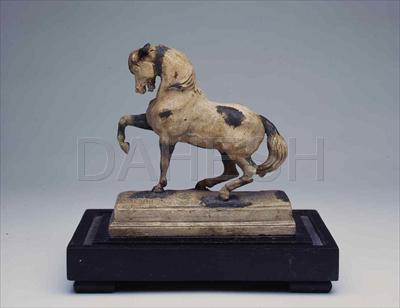Antoine-Louis Barye (French, 1796–1875)
Turkish Horse, ca. 1876
Plaster with wax in ebonized wood, 5 1/4 x 2 1/8 x 5 1/8 in.
Signed on base right: BARYE
2002.47

Cheval Turc no. 4 (Turkish Horse no. 4), antérieur gauche levé, terrasse carrée (raised left front leg, square base)
The composition of Barye’s Turkish Horse is informed by the famed equestrian statue of Marcus Aurelius in Rome (161–180 CE, Capitoline Museum, Rome), but also demonstrates how completely Barye internalized the anatomical clarity and compositional tension found in the horse imagery of Théodore Géricault (1791–1824), which Barye studied. Barye modeled no less than seven different versions of Turkish Horse, this being one of only two known original plasters for the smallest bronze reduction he created. Adding wax patches to the surface of the plaster allowed the artist to further enhance the details of his modeling, and they now offer an unusual insight into the processes of casting sculpture in the 19th century. The dating of the various models is quite complex as different foundries produced them over a long period of time.


